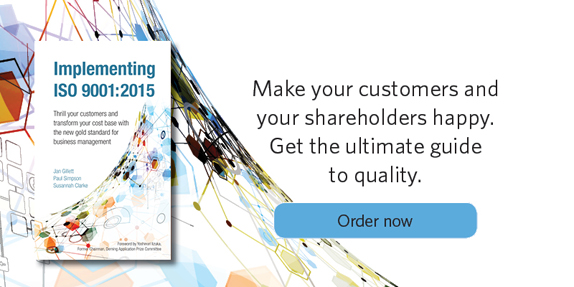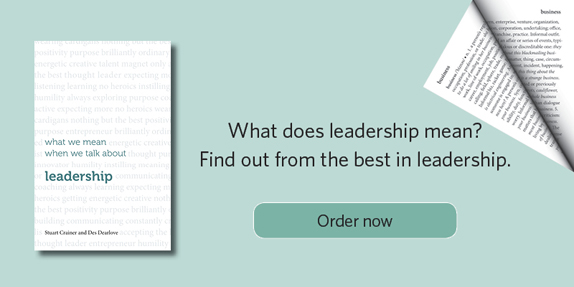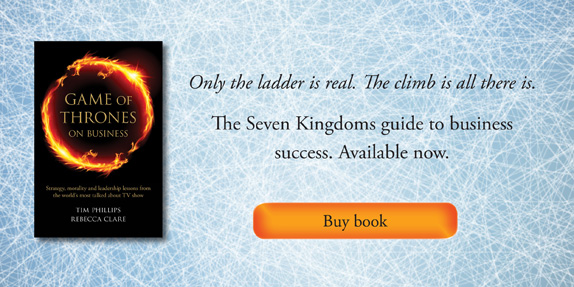Business and finance
How can you make the book you’ve written work for your business?
11 January 2016 by Richard Burton in Book publishing, Business and finance, Publishing for business
Over the years Infinite Ideas has published dozens of books with businesses and the research we’ve done shows that a printed book is a unique promotional tool. We found that out of ten thousand consultants in the UK 72% of respondents claimed that as a result of being published recognition of their brand increased; nearly 60% claimed that they picked up more speaking events after being published and 65% stated that being published gained them more clients. That’s quite compelling, and it supports some of our own anecdotal evidence. One Infinite Ideas author gained a six figure consulting contract as a result of his book being bought at an airport bookshop; another ended up as a speaker at the World Economic Forum at Davos two years in succession.
 Many authors think that writing their book is hard work but soon find that writing is the easy part! There’s no point putting all those evening and weekend shifts in on your book if you then fail to work it to increase sales and brand awareness, and that requires a degree of diligence and innovation. Your publisher will (or should) work hard to secure presence in bookshops and generate media coverage but can do very little to access the constituency that has already bought into your brand – your clients, audiences and followers. So here are some tips for maximizing the impact of your book.
Many authors think that writing their book is hard work but soon find that writing is the easy part! There’s no point putting all those evening and weekend shifts in on your book if you then fail to work it to increase sales and brand awareness, and that requires a degree of diligence and innovation. Your publisher will (or should) work hard to secure presence in bookshops and generate media coverage but can do very little to access the constituency that has already bought into your brand – your clients, audiences and followers. So here are some tips for maximizing the impact of your book.
- Send a signed complimentary copy with a personal, handwritten letter to all your clients and prospects. Explain why you have written the book and how you think it will help them specifically. Individualize each letter as far as you can. Writing it by hand rather than typing strengthens the impression that you have taken the time to think about the person who is reading it and their business or professional needs. Nobody gets excited by a generic template.
- Send a copy to each of your media contacts with a note pointing out aspects of the book that you think are newsworthy. In a recent survey 32% of people said they bought a book because they were influenced by reviews in newspapers, magazines and online, so you can’t afford to ignore it. Once again, your publisher should be working the media but you will need to fill in the gaps. So find out what they are doing and work with their PR to generate maximum exposure. Journalists get hundreds of approaches a week so yours needs to stand out and there’s no better way of doing that than by personal contact. If you don’t have any media contacts ask friends and colleagues for theirs and use their names (with their permission) in the subject box of your emails.
- If you’re not already on the speaking circuit now’s the time to start. Speaking engagements are a priceless channel for selling your book. Ideally you should build a free copy for each delegate into the fee you get for the event. If that’s not possible take some books to sell (and make sure you have a facility for taking payment). At the very least you should have some fliers available that give your audience details of your latest book, preferably with a discount. If you have impressed your audience many will want a souvenir of the event and what could firm up your relationship with these potential new clients better than a signed copy of your book.
- Social media is (are) vital. Start promoting your book a few months prior to publication on Facebook and Twitter and encourage as many people as possible to become fans and share your book in their networks. These are more fun social networks and designed to give instant gratification. To stay relevant create a hashtag that is unique to your brand and use it every time you post a tweet or an update. This should develop momentum and you will be able to monitor whether people are responding to your contributions. You should also explore Tumblr and Pinterest which are particularly good at being visually stimulating and easily shared. Make sure the pictures you associate with your brand and your book are relevant to the content, otherwise you may end up with the wrong types of followers, those who are not likely to benefit from reading your content. It’s good to link your posts to what is currently trending, but always link back to why that is relevant to your book.
If your book is designed to promote your business you must engage fully with LinkedIn, which is an essential networking tool. Join groups on LinkedIn that relate to your business. It is an excellent space to share newsworthy items that can help with careers, and members are likely to respond if you write a blog post and share it (always with a link to your book at the end). Promote thoughtful content that gets people to engage with the ideas in your book and engages them in discussion. Reach out to people who you think could endorse your book, such as leaders in your particular field, or an author of a competing title. You don’t get any medals for wanting to do all of this alone.
There’s much more that you can do of course, and I’ll be returning to this subject with more techniques to market your work. Meanwhile we have written two books which are available free on www.infideas.com
Get published: A first-time writer’s guide to publishing
Guerrilla tactics for marketing and selling your book
We love to talk to authors about their books. If you want to have an informal chat, feel free to email us at info@infideas.com to see how we can help you out.
Making it in a man’s world. We talk to Susannah Clarke, co-author of Implementing ISO 9001:2015
6 January 2016 by Catherine Holdsworth in Business and finance, Implementing ISO 9001:2015
Engineering and process management are sectors that are dominated by a male workforce. While it may seem to be a ‘man’s world’, Susannah Clarke, co-author of Implementing ISO 9001:2015: Thrill your customers and transform your cost base with the new gold standard for business management has over 30 years’ experience in this industry. As one of the Managing Partner’s at Process Management International, (PMI), Susannah promotes quality management, writes articles, speaks at conferences, coaches and consults on organisational improvement.
In between promoting her book and working at PMI, Susannah kindly answered some of our questions about what it’s like to work in such a male-dominated sector.
 What is it about engineering and process management that appeals to you?
What is it about engineering and process management that appeals to you?
My father is an architect, so I guess the root of it all comes from that. I was amazed by the need to be precise, which at first seemed tedious as a child, but then watching the result, seeing something innovative and creative be built, from those thousands of small details I found quite inspiring. Having said that, in my business life I haven’t always been a fan of process. I struggled to see the link into the service world in which I was working, and in the early days made that common mistake of imagining that process made work restrictive, boring and repetitive.
However as my business grew, and more people had similar jobs to perform, I soon realised that without process, mistakes were made which resulted in unhappy customers and employees spending time on fixing the mistakes as opposed to delivering what the customer wanted. So we started to change that and worked on creating robust processes for the work that was being done and as a result found ourselves able to go to customers and make suggestions, show them how we could do things better, faster and right first time and not only did that make the customer happy, it meant they gave us more work! That appealed to me, naturally and it also appealed to the people working with me because they could think about the art of the possible and not be limited by the amount of ‘fire-fighting’ and problem solving they had to do.
Have you ever come across people who weren’t willing to be directed by a woman?
To be honest no, I haven’t. That’s not to say I haven’t dealt with some difficult people, but inevitably there is more to the problem. I’ve always worked hard to sit down with people, customers and staff, to find out what’s going on, what bothers them and what I can do to help the situation. At PMI (Process Management International) we call it ‘Giving people a good listening to!’ My experience has been that when people really believe you care, when you’re not just paying lip service to their complaint, then they start to work with you and become a returning client. After that, it doesn’t matter whether you are a man or woman they are happy to work with you because they trust you.
There are many women working as business consultants. What made you switch from large companies like NatWest and GSK to the world of engineering and process management?
When I left NatWest I became self-employed and started my own business as a trainer. I’ll be honest, at that time I was very against working for a large company, having gone through Black Monday in the City and seen the departure of many members of staff. So I was very happy to be working as my own boss. My opportunities grew and I had to start sub-contracting work to other trainers in order to service all the customers and then eventually I merged my business with another very similar size business that was also run by a female owner-founder and created a new consultancy, Prelude.
The aim wasn’t to avoid large companies, it was to have the freedom to shape our own company and community – to work with a group of like-minded people who wanted to do the best job for a customer. We could be nimble and adapt to our environment to offer new services. It was during this time that process management became important to us in order to service new and existing customers and continue to grow. We were also flexible in our hiring policy and had several women who were employed part time doing fantastic jobs, helping them through their maternity leave and return to work as it suited them. As a consequence these employees were incredibly loyal to us.
Around 2004/2005 one of my clients asked us to take on managing a service for training administration for a large process improvement/lean six sigma programme they were rolling out with a company called PMI (Process Management International). That was the first time I had worked with the company and I was impressed by how they were organised and the processes they had in place to manage the training. We continued to work together and develop the opportunities beyond that original client. In 2007 I had sold the business and completed my earn out and PMI offered me some consultancy work with them. They also offered me the chance to go on a Lean Six Sigma Green Belt course, which almost blew my mind! I learnt so much in such a short space of time and had so many ‘ah ha’ moments. After that there was no going back.
I’m not saying I don’t get carried away and sometimes forget those principles, but I’m lucky enough now to work with some brilliant consultants who have many years of experience in this field and they are masters at catching me before I shoot off in the wrong direction.
I still think of myself as someone who works with large companies. I just don’t work for them!
How have things changed in the past 30 years for women operating in the manufacturing industries? And what advice would you give to young women entering the world of engineering and process management? (Or business in general?)
We still have a dearth of women in manufacturing and engineering. Read any of the studies on these sectors and they indicate that around one third of the manufacturing workforce and only around 15 to 20% of the engineering workforce is female. Research attributes this to gender pay inequity, work-life balance, insufficient women at the senior executive level and so on, but realistically women only become really aware of these challenges once we have entered industry, don’t we? So isn’t the question more about how do we make a career in these sectors more attractive to women?
Fundamentally I believe we need to start early with the right education in schools and the elimination of stereotypes. When I was 16 I went to a boys grammar school. There were only eight girls in my year, so the school didn’t cater for ‘girl’ subjects. I studied woodwork, graphics and metalwork along with the boys, all the girls did, and I rowed in a coxed four because there weren’t enough of us to make a girl’s team for netball or hockey. I think this helped to break down traditional stereotypes for me. The other thing I found was that from age 11 onwards the boys had specific lesson time allocated to debate current affairs. They had been taught and encouraged to create cohesive, constructive arguments as part of their education. They were preparing the boys from an early age to have a view, be able to express it and learn how to prepare for such discussions. I know we do more of that in our schools today, certainly my daughters are proficient at creating a strong argument! But I still put my head in my hands when I look at the Design & Technology options available to them and their female bias.
What advice would I give them?
There are no limits except those you impose upon yourself. That’s the best advice I could give a woman.
- Understand Systems Thinking, regardless of which sector you work in, whether it is service or manufacturing. Get to know W. Edwards Deming’s System of Profound Knowledge, Systems Thinking, Theory of Knowledge, Variation and Psychology. The four elements are essential to your own and your organisation’s success. Once you understand these and have a decent personal kit bag of tools and methods you can call upon in the different situations or challenges you find yourself, you will be amazed at how good you feel about what you are doing and what you can achieve.
- Be naturally curious rather than jumping to solutions. The more you can ask about what’s going on, using great open questions which avoid making others feel defensive, the more people will open up to you and involve you so that you can learn about the current situation and contribute towards what improvements may be possible in the future.
What have you found the most challenging aspects of working in this field?
There’s so much to learn! But that’s good because I really enjoy learning. However it’s important to remember when to ask for help from others with more knowledge and experience. Influencing others to trust the methods comes a close second. People get into their own habits. They have always done things their way or the way they were told, so persuading them to suspend judgement, try new approaches, change their thinking, is naturally sometimes hard work.
What is the most rewarding part of your job?
There is nothing quite like working with either an individual or team who are struggling and gradually seeing their lights come on as they start to realise what options are open to them, that there are some theories they can have a go at.
There is also something about people realising that they don’t always have to be right first time. I’m not suggesting that people should go off and make huge changes without considering the consequences of course. But helping people realise that they can consciously try small changes, test out a theory or two, see what results they get, learn from the results and then adopt (do it), adapt (change it) or abandon (discard it completely), is very liberating for them. People can get obsessed with things being either right or wrong. I don’t think that’s helpful. I think that prevents people trying new ideas, so giving them an environment, a method, which enables them to make mistakes in a controlled way is amazingly rewarding because they become so enthusiastic about what’s possible by working that way.
Is there anything you think you would have done differently knowing what you know now?
It is absolutely true that “If I knew then what I know now I would have done things differently, deliberately rather than based so much on gut feel.” I started my first business when I was about 22 and I knew how to work hard and was happy to work hard, but I didn’t know anything about systems thinking or process management so I would have made different decisions with data. In 2007 I studied Executive Coaching and Performance Coaching and that has really had a huge impact on my ability to listen, ask questions and coach others and whilst I wasn’t bad at that before, I could have been so much better if I had really developed those skills earlier in my career.
Game of thrones on business is an excellent stocking filler
22 December 2015 by Catherine Holdsworth in Business and finance, Game of Thrones on Business
Unless you’ve been hiding under a rock these past few months, there have been speculations running wild about the new series of Game of Thrones and, um, well…yeah, turns out that Jon Snow might still be alive. I mean, we certainly didn’t ever think this, we know nothing after all. We definitely didn’t believe it when we saw Kit’s luscious locks at Wimbledon, nor were we swayed when we saw pictures of him on the set. No, sir. If you tell us he’s dead, George Martin, then we believe you.
 And then HBO released the new poster for season six. Well, we were perhaps taken unawares. Not for a second did we ever believe the
And then HBO released the new poster for season six. Well, we were perhaps taken unawares. Not for a second did we ever believe the conspiracy fan theories that suggested Jon would come back and then we are thrown a curve ball.
So it turns out we really do know nothing about season 6. And as 2015 draws to a close, we’re thrilled that it will only bring us closer to what is promising to be an almighty instalment in the Game of Thrones series. If, however, you are struggling to come to terms with this shocking news, and are wondering what to get Steve from HR for Secret Santa, perhaps you should look no further than our very own Game of Thrones on Business by Tim Phillips and Rebecca Clare, shortlisted for the CMI Management Book of the Year, it provides excellent tips on how to use tactics and strategies from the show in the workplace. Did we mention that it fits in a stocking as well? We’re pretty sure that there is just enough time to order a copy for your colleague, loved one, Grandma, neighbour and mortal enemy.
What do leaders really do?
17 December 2015 by Catherine Holdsworth in Business and finance
The C-Suite is the goal for many budding entrepreneurs who are rising through the ranks of businesses, leadership is a position that so many people aspire to. But what does leadership actually mean? And, more importantly, when you reach the position of leader, what do you really do? Stuart Crainer and Des Dearlove, co-authors of What we mean when we talk about leadership seem to have the answers…
Mid-way through the Wimbledon Men’s Singles Final the television cameras scanned the crowd in the royal box. There were past winners, sporting greats, politicians and celebrities of various degrees of permanence. Among them was a single figure who appeared less intent on the irresistible rise of Novak Djokovic and more on the smart phone in his hand. He was Sir Martin Sorrell, the CEO of WPP.
For the modern leader there is no rest from the steady stream of emails, the demands on their time. There is no hiding place. Sixty percent of CEO time is taken up by meetings; CEOs spend 25 percent of their time on phone calls and at public events; only 15 percent of CEO time is spent working alone. It has been estimated in the California Management Review that managers can spend two to three hours each day reading, sending and responding to emails. And then there are mundane traditional tasks – more research suggests that, on average, paperwork and related tasks consume 11.6 hours per week or approximately 25 percent of a manager’s time, with senior managers both spending more time on these tasks and finding it more disruptive than middle managers.
At the very top, there appears a relish for such demands. Sir Martin famously promises to reply to anyone in WPP who emails him within twenty-four hours. He calculates that for anyone to bother the CEO it has to be something important. (We have emailed Sorrell and he is true to his word.)

Talking with one CEO, he summed up his modus operandi: ‘The reality is that every time I am on the move, I make a call; every time I have a break I call someone. I go through a mental list of who I haven’t spoken to for a while or someone who I know has a new piece of work on, or family news – they’ve just had a new baby or something.’
And yet, here was a man clearly happy in his work. ‘The life of a CEO is not for everyone,’ he told us. ‘It is a grueling, stressful and often lonely, existence. It is physically, mentally and emotionally demanding. And, of course, there is no guarantee of success or even survival in the post. So why do it? Because, on a good day, it is also the best job in the world.’ (We should note that for this individual the best job in the world was his for only a couple of years before an internal spat saw him ejected.)
Most jobs come with a job description, a lengthy list of the exact parameters of responsibility. But when you reach leadership roles, the job descriptions come to an end. You are left alone to make it up as you go along. The only sure thing is that you will be expected to deliver results.
The loneliness can be oppressive – and partly explains the rise of the executive coaching industry. Not knowing what it is you should do or when or with who, offers more freedom than most executives have usually experienced in the corporate cocoon. In their previous incarnations executives have often been purveyors of certainty; as leaders they find that uncertainty rules. It can bewilder even the best prepared.
Little coherent research has been done as to how leaders do and should manage their daily working lives. (‘Filling out a six-page academic survey is rarely high on a CEO’s daily to-do list,’ reflects London Business School’s Rajesh Chandy.) Indeed, the reality largely went unexplored until Henry Mintzberg’s The Nature of Managerial Work, was published in 1973. Instead of accepting pat answers to perennial questions, Mintzberg went in search of executive reality. He simply observed what a number of managers actually did. The resulting book blew away the managerial mystique.
Rather than spending time contemplating the long term, Mintzberg found that managers were slaves to the moment, moving from task to task with every move dogged by another diversion, another call. The median time spent on any one issue was a mere nine minutes – remember this was nearly a quarter of a century before email. In The Nature of Managerial Work, Mintzberg identifies the characteristics of the manager at work. The manager:
- performs a great quantity of work at an unrelenting pace;
- undertakes activities marked by variety, brevity and fragmentation;
- has a preference for issues which are current, specific and non-routine;
- prefers verbal rather than written means of communication;
- acts within a web of internal and external contacts;
- is subject to heavy constraints but can exert some control over the work.
This may sound familiar.
Over thirty years later in Managing, Mintzberg revisited the subject of the 1973 book. He argues that the nature of managerial work hasn’t actually changed:
The content of managing changes all the time – what you’re dealing with, how your industry is structured – but the process hasn’t changed. The one big thing is the Internet and especially email, but I think those forms of communications just reinforce problematic behavior. So I think they’re just making it worse, but I don’t think they’re changing management fundamentally. One thing that I admit has changed is that management has been ignored in favor of leadership.
(The relationship between management and leadership is often discussed. We regard leadership as management on steroids, heightened and intense, but from the same essence.)
Mintzberg contends that though communication is a huge part of the job of management – managers spend 50 percent of their time, in some cases, on communication – this is nothing new. He cites a 1940s study of Swedish managing directors which found that they were inundated with reports and couldn’t keep up. The world has changed, but the essence and frustrations remain largely consistent. Leadership is a 24/7 job.
Resources
www.bnet.com/blog/business-research/study-how-ceos-really-spendtheir-time/1123
Henry Mintzberg was the recipient of the Lifetime Achievement Award at Thinkers50 2015. More of his sometimes trenchant, often entertaining and usually illuminating views can be found at www.henrymintzberg.com
Risk and opportunity go hand in hand when updating to the new ISO standard
4 December 2015 by Catherine Holdsworth in Business and finance, Implementing ISO 9001:2015
Paul Simpson, co-author of Implementing ISO 9001:2015 looks into how taking risks and opportunities is key when building a business but can the updated ISO standards help to deliver that elusive ‘pot of gold’?
One of the big new ideas in the 2015 edition of ISO 9001 is ‘Risk Based Thinking’ and if you are to believe the Twitterati the concept is akin to the subject of Edvard Munch’s painting ‘The Scream’ as the quality management landscape turns vibrant orange behind them. But before the hysteria needle hits 11 let’s think back to the real world outside the quality manual.
 All people running organisations look at risk and opportunity, they are two sides of the same coin; when an entrepreneur starts their business risk and opportunity are always front and centre in their mind. Wherever they have come from, they have identified an opening to start a business, make a living, and grow it to the point where it gives them an income with the opportunity of a pot of gold for their retirement. This future is, however, not certain; there will be difficulties along the way and these risks, left unmanaged, could lead to a loss of income and, ultimately, to their business failing. The entrepreneur recognises these risks come in many forms and many are related to quality: do I have the right products and services for my target customers? Can I control production and service delivery to consistently meet those customer needs? Can my suppliers keep up with my demands and maintain quality levels I need? If I can manage those risks at that level then the business will succeed and I can grasp all the opportunities, including that elusive pot of gold.
All people running organisations look at risk and opportunity, they are two sides of the same coin; when an entrepreneur starts their business risk and opportunity are always front and centre in their mind. Wherever they have come from, they have identified an opening to start a business, make a living, and grow it to the point where it gives them an income with the opportunity of a pot of gold for their retirement. This future is, however, not certain; there will be difficulties along the way and these risks, left unmanaged, could lead to a loss of income and, ultimately, to their business failing. The entrepreneur recognises these risks come in many forms and many are related to quality: do I have the right products and services for my target customers? Can I control production and service delivery to consistently meet those customer needs? Can my suppliers keep up with my demands and maintain quality levels I need? If I can manage those risks at that level then the business will succeed and I can grasp all the opportunities, including that elusive pot of gold.
Moving forward in time as the business continues to thrive and has grown, our entrepreneur has moved upstairs to the board room as CEO and has managers and teams dealing with day to day business while she buys in high priced consultants to lead some blue skies strategy sessions. Strategic risks haven’t really changed; an incorrect strategy still has the capability to bring down our grown-up start-up. Tactically the business can cope more easily with risk as it has multiple customers buying a range of products. On the down side tactical errors can lead to an erosion of hard earned brand reputation as all our customers inhabit the same system and talk to one another – see the earlier blog on organisational context (hyperlink) for examples.
Moving out of the board room along to the shop floor and offices where ‘business as usual’ happens risk looks a little different but it is just as important it is recognised and managed. With every order comes a risk the organisation will misunderstand their customer’s needs so, at this process level, there have to be checks and balances. Individuals working with their CEO’s delegated authority accept orders and enter into contracts including the inherent risks a legal contract carries. At the same time on the shop floor all employees are involved in managing risk. Some develop specifications and standards (perhaps in a separate design office); some manufacture products or deliver services that they believe meet those standards. Throughout the process managing risks leads to delivered products and services meeting specification, satisfying customer needs and customers paying their bills, thereby allowing the organisation to realize the sales opportunity and contributing to our entrepreneur’s vision of a pot of gold.
If the above risks and opportunities are present in daily organisational life why do we have concerns for the quality professional’s ability to inhabit this space and over what our certification body auditors are going to ‘do to us’? The revised clauses of ISO 9001 create an opportunity for us to revisit and realign our processes to ensure our systems deliver what our customers and stakeholders want. There are, of course, risks with changes to the standard but perhaps we can focus on the opportunities presented and maximize them instead.




